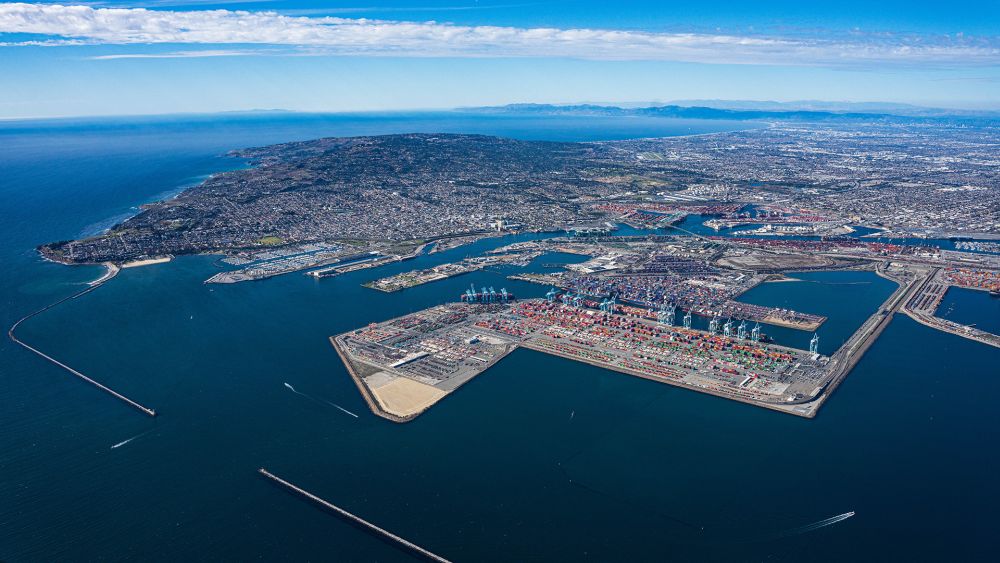
[ad_1]

Los Angeles and Long Beach ports continue to operate at full capacity. Southern California’s Marine Exchange reported 100 vessels berthed on 18 October, topping the earlier record of 97 observed on 19 September.
Both figures are much higher than what was recorded in the pre-pandemic period when 17 ships used to be anchored. To cope with the unexpected surge, port officials have been resorting to holding areas that have been unused since 2004.
Cargo carriers have had to wait up to five weeks for unloading the goods. Crews are bored to tears. These days they sit on the ship, look onshore, eat three meals every day, and stand watch.’

Representation Image – Credits: @PortOfLA – Twitter
Once the containers arrive at the land, it takes weeks to queue them before unloading. Of the vessels present at the harbor on Monday, 33 container vessels had been stuck at the holding areas, breaking the earlier record of 29 as of 20 September.
Captain Kit Louttit, the executive director of the marine exchange, said that he had never seen anything like that. He added that it’d be a record to have 100 vessels there. ‘The number of container ships out there is 70, so there’s your holiday shopping.’
The White House has warned Americans last week that they would not be able to purchase items like kids’ toys for the holiday season owing to backlogs in the supply chain.
Stores across America are becoming barren thanks to the bottlenecks encountered in the supply chain worldwide. Many goods that are manufactured in China like clothes, toys, and home appliances are stuck either in the country’s factories or in containers on cargo ships off the coast, waiting to dock.
The US President, Joe Biden, has reached a deal on 13 October with business leaders and unions from enterprises, including FedEx, UPS, and Walmart to expand the operations at ports to ease out the bottlenecks in the supply chain that are shooting up prices and resulting in empty store shelves.
Wal-Mart, Samsung, Target, and Home Depot pledged to increase their outputs overnight by over 3,500 shipping containers each week.
Under the new agreement, the Los Angeles port will join the Long Beach port to work round the clock and help reduce some of the supply chain bottlenecks that are plaguing buyers before the upcoming holiday season.
Cumulatively, the California ports see 40% of shipping containers that reach the US. In September, Long Beach had expanded nighttime operations.
Currently, officials at the Los Angeles port as well as union leaders have agreed to add off-peak nighttime hours besides weekend hours to lower consumer prices.
Per Daily Mail’s report, some of the White House officials have reported that goods at the Los Angeles port moved 25% faster in the night compared to that during the day.
They argue that expanding overnight operations is expected to lighten the load on other links in the whole supply chain by easing out traffic congestions during the day.
The backlog is disappointing residents, who have reported that empty shipping containers often get dumped in the local communities.
The Port of Los Angeles processed 903,865 Twenty-Foot Equivalent Units (TEUs) in September, the busiest September ever in the Port’s 114-year history. Year to date, overall cargo volume stands at 8,176,917 TEUs, an increase of 26% compared to 2020.
“Despite the global supply chain challenges, the Port of Los Angeles and its partners continue to deliver record amounts of cargo,” said Port of Los Angeles Executive Director Gene Seroka. “This is made possible by the extraordinary effort of our longshore workers, truck drivers, terminal operators and so many others on the waterfront and in our region’s warehouses. I’m grateful to all of them.
“Of particular note is the great work by BNSF and Union Pacific, which have reduced the rail backlog in half in the last month and by two-thirds over the last two months,” Seroka added. “We’ve got more work to do but we’ve made significant progress due to the collaborative efforts with our Class 1 railroads.”
September 2021 loaded imports reached 468,059 TEUs, about the same amount compared to the previous year. Loaded exports dropped 42% to 75,714 TEUs compared to the same period last year. It was the lowest number of exports since 2002.
Empty containers climbed to 360,092 TEUs, a jump of 28% compared to last year due to the continued demand in Asia. In total, September’s 903,865 TEUs was 2.3% above last September’s previous record of 883,625 TEUs.
Reference: dailymail.co.uk
Largest Ports Of California Witness 100 Vessels Berthed Amid Ongoing Supply Chain Crisis appeared first on Marine Insight – The Maritime Industry Guide
[ad_2]
This article has been posted as is from Source